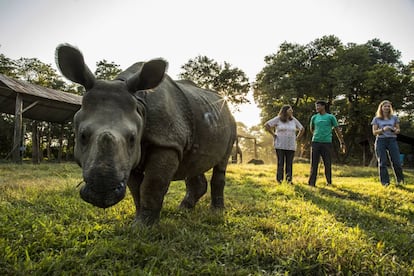The veterinarian working to save man-eating animals
A Madrid-based doctor is fighting the common diseases that infect tigers and other endangered animals

The young Rajan Sanu, still beardless, shows a picture he took with his cellphone a few months ago. On the screen, on a path in the middle of the jungle, there is a disemboweled corpse, its intestines protruding from his abdomen. “He was 28 years old. He was eaten by a tiger.”
It is not a strange event in his village, he says. Sanu lives in Sauraha, a locality of about 2,700 inhabitants located in the vicinity of Chitwan National Park, in southern Nepal. The place is one of the last strongholds of the so-called “man-eater,” the Bengal tiger. Of the fewer than 2,500 remaining Bengal tigers on the planet, 120 live in this area. The rest are concentrated in India, Bangladesh, Nepal and Bhutan.
About 120 of the fewer than 2,500 remaining Bengal tigers on the planet live in Chitwan
Local newspapers are used to publishing the same news, with different victims. On October 2, a tiger mauled a 25-year-old woman to death after she entered the jungle to gather food for her livestock. Between 1979 and 2014, tigers have killed 120 people in Chitwan.
The jungle, now considered a World Heritage Site by UNESCO, used to be a hunting ground for Nepalese royalty for more than a century. Legend has it that the maharajah Jung Bahadur Rana shot 31 tigers all by himself in the winter of 1861 on the back of his elephant. And the killing continued in the 20th century, until humans exterminated more than 95% of the 100,000 tigers that once swarmed through the jungles of Asia. But, in Chitwan, the tiger’s rival is no longer the shotgun. It is an invisible enemy.
In early May 2017, US veterinarian Deborah McCauley made a historic journey from the Nepalese jungle to Cornell University in New York. She carried with her samples taken from 11 Bengal tigers. For the first time, the species’ blood serum had left Nepal for analysis. And the preliminary results were alarming: tigers are exposed to diseases that they share with humans, dogs and cows.

“Around the world, endangered wildlife is dying due to diseases shared with domestic and human animals. It’s happening on a global scale,” warns McCauley, who was born in New York but lives in Madrid.
The veterinarian recites examples from all over the planet. Two years ago, she recalls, more than 200,000 Saiga antelopes were found dead in a few days in Kazakhstan, victims of bacteria. The infection decimated a third of the world’s critically endangered antelope population.
This is an emergency on a global scale and time is running out Deborah McCauley, veterinarian
In North America, white-nose syndrome caused by a fungus has killed millions of bats in the last decade. In Russia and India, corpses of tigers infected with distemper virus have cropped up, the same virus that affects dogs. In Africa, lions are suffering from dangerous outbreaks of tuberculosis.
“Millions of dollars are dedicated to reducing poaching and protecting habitats, but there is very little money, if any, going to improving the health of threatened wildlife,” McCauley laments. Five years ago, she and her colleague Gretchen Kaufman founded the Veterinary Initiative for Endangered Wildlife (VIEW), to address this forgotten front in the global fight for environmental conservation.
Nepal is its testing ground. There, McCauley’s team works with the National Trust for Nature Conservation (NTNC), a government organization that employs the person who has possibly caught the highest number of live tigers in history. “I have captured more than 100,” says Bishnu Bahadur Lama, a friendly 62-year-old man whose job is to chase tigers through the jungle.

It’s an extraordinary show to watch. When a tiger is prowling about the villages or attacking people, an operation gets underway: hundreds of meters of ropes with white sheets hanging from them are stretched from tree to tree all around the predator. The white color works like a wall for the animal. At the same time, 10 or 15 men on the backs of as many elephants push the tiger into the improvised corral. Once he is trapped among pachyderms and linen, Bishnu Bahadur Lama shoots a well-aimed anesthetic dart at the animal’s muscles.
Prior to relocating dangerous tigers to remote areas away from human populations, Lama’s team takes samples for VIEW to analyze. McCauley fears cases of parvovirus, a disease that causes deadly bloody diarrhea in puppies in the villages near Chitwan. Leptospirosis, a bacterial infection that can be deadly in humans, and distemper are the other threats.
No one knows the magnitude of these threats because no one in the world is investigating them Deborah McCauley, veterinarian
In Chitwan, wildlife lives side by side with humans and domestic animals because of the conversion of the jungle into agricultural land. When dusk falls in Sauraha, it is customary to see two-ton rhinos calmly strolling down the streets, surrounded by gaping tourists who went out for a beer.
This coexistence is dangerous for both sides, warns McCauley. Deaths from tiger attacks have spiked from one per year before 1998, to peaks of seven annual casualties in recent years. VIEW has also documented cases of five tigers who appeared thin and disoriented, with symptoms compatible with distemper. In villages near Chitwan, 27% of dogs have been infected with the virus, according to the organization’s analysis. Vaccinating these pets would prevent their diseases from spreading into the jungle.
“No one knows the magnitude of these threats because no one in the world is investigating them,” McCauley says. On February 16, 2015, national park rangers observed a female Indian rhinoceros who was apparently ill. She was lethargic and refused to eat. The next day the officers found its corpse. The Nepalese veterinarian Amir Sadaula, who was trained by McCauley, confirmed their suspicions: tuberculosis. It was the first case detected in Asia, where the last 3,500 Indian rhinoceros live.

“We regularly see herpes virus infections in elephant calves under the age of five. The mortality rate is 90%, and if an animal becomes infected with herpes, it dies in six or seven hours,” says Sadaula. The Nepalese government maintains 200 captive elephants in Chitwan for use in their jungle patrols against poachers. Herpes has killed six of their offspring in recent months. “It's a major problem, in Nepal and in the rest of the world,” says Sadaula.
“In places such as Chitwan, where excellent work has been done to reduce poaching and provide a habitat for endangered wildlife, the main cause of death is natural or unknown causes,” McCauley says. The veterinarian speaks at the site of what will be a three-story hospital for wild animals in the national park in the coming months.
“Chitwan is an excellent model to show the rest of the world how wildlife health can be included in environmental conservation,” she says. “It is urgent to investigate these diseases with diagnostic techniques of veterinary medicine. This is an emergency on a global scale and time is running out.”
English version by Debora Almeida.
Tu suscripción se está usando en otro dispositivo
¿Quieres añadir otro usuario a tu suscripción?
Si continúas leyendo en este dispositivo, no se podrá leer en el otro.
FlechaTu suscripción se está usando en otro dispositivo y solo puedes acceder a EL PAÍS desde un dispositivo a la vez.
Si quieres compartir tu cuenta, cambia tu suscripción a la modalidad Premium, así podrás añadir otro usuario. Cada uno accederá con su propia cuenta de email, lo que os permitirá personalizar vuestra experiencia en EL PAÍS.
¿Tienes una suscripción de empresa? Accede aquí para contratar más cuentas.
En el caso de no saber quién está usando tu cuenta, te recomendamos cambiar tu contraseña aquí.
Si decides continuar compartiendo tu cuenta, este mensaje se mostrará en tu dispositivo y en el de la otra persona que está usando tu cuenta de forma indefinida, afectando a tu experiencia de lectura. Puedes consultar aquí los términos y condiciones de la suscripción digital.
More information
Últimas noticias
Venezuela hardens its ‘revolutionary state’ project amid pressure from Trump
Sydney Sweeney, the actress praised by Trump: ‘Women are up against what society wants them to be’
The Bolsonaro surname: An advantage or liability in Brazil’s 2026 presidential elections?
Raúl Rocha, from jet-setting with Miss Universe to arms trafficking and fuel theft
Most viewed
- Reinhard Genzel, Nobel laureate in physics: ‘One-minute videos will never give you the truth’
- Pablo Escobar’s hippos: A serious environmental problem, 40 years on
- Charles Dubouloz, mountaineering star, retires at 36 with a farewell tour inspired by Walter Bonatti
- Why we lost the habit of sleeping in two segments and how that changed our sense of time
- The fall of a prolific science journal exposes the billion-dollar profits of scientific publishing










































